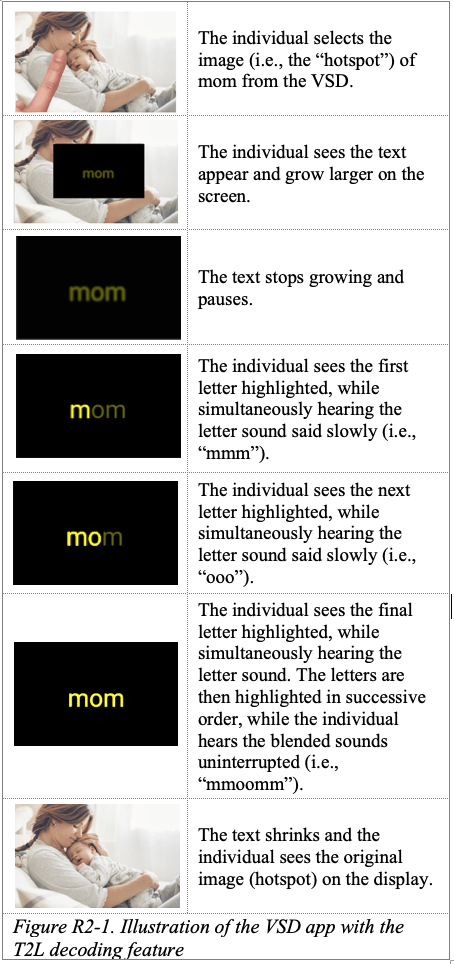Currently, literacy outcomes for the more than 3.5 million individuals with developmental disabilities and complex communication needs are very poor; more than 90% do not have functional literacy skills. A major barrier to literacy learning is the design of current AAC technologies. Individuals with complex communication needs who are nonliterate use AAC systems with pictures or photos; these systems do not support literacy learning. The research suggests that users do not attend to the small, static, text labels that are typically provided above picture symbols; indeed, the symbols may actually block processing of the written words. Stakeholders have consistently highlighted the urgent need for the development of new AAC technologies that support the acquisition of literacy skills (specifically decoding, that is, the use of letter sound knowledge and sound blending to read words). Such technology has broad application for children and adults with a wide range of developmental disabilities who are not literate.
Developing literacy skills is a complex process that rests on the fluent integration of knowledge and skills across a wide range of domains, including, for example, language skills, background knowledge, phonological awareness skills, letter sound correspondences, decoding, and sight word recognition.
Learning to decode is facilitated by the integration of:
• orthographic processing (i.e., knowledge of letters and letter patterns);
• phonological processing (i.e., identification, manipulation, and memory of the sound structure of speech);
• meaning processing (i.e., knowledge of words and their meanings); and
• contextual processing (i.e., use of background knowledge to derive meaning from text) (e.g., Adams, 1994).
We propose the development of grid-based and visual scene display (VSD) apps with transition to literacy (T2L) features to support the acquisition of decoding skills. The desired features for this app include the following:

(a) dynamic smooth movement of text (upon selection of a graphic symbol from the AAC display), using motion to draw visual attention to the text (cf. Jagaroo & Wilkinson, 2008) to support orthographic processing;
(b) pairing of the written word with speech output to support phonological processing;
(c) use of luminance (i.e., brightness contrast) to attract visual attention to the individual letters within the context of the entire word;
(d) pairing of each highlighted letter with the letter sound to support phonological processing;
(e) origination of the text from the graphic symbol to support the association of the symbol and the text and thereby support understanding of the meaning of the text;
(f) replacement of the graphic symbol by the text to make the word salient and eliminate distraction;
(g) targeting words for the symbols within the learner’s AAC system to ensure that concepts are known thus supporting the association of meaning with the text.
The broad context provided by the AAC display and the communication situation may also support learning. The exposure to text is infused into the individual’s AAC system, thus ensuring that literacy learning is driven by the individual’s interests and needs (Light & McNaughton, 2009).
References
Adams, M. J. (1994). Beginning to read: Thinking and learning about print. MIT press.
Jagaroo, V., & Wilkinson, K. (2008). Further considerations of visual cognitive neuroscience in aided AAC: The potential role of motion perception systems in maximizing design display. Augmentative and Alternative Communication, 24, 29-42.
Light, J., & McNaughton, D. (2009). Addressing the literacy demands of the curriculum for conventional and more advanced readers and writers who require AAC. In Zangari, C., & Soto, G. (Eds) Practically speaking: Language, literacy, and academic development for students with AAC needs, 217-246. Brookes Publishing.
Cite as: Light, J., McNaughton, D., & Jakobs, E. (2019). Design of transition to literacy (T2L) decoding feature. RERC on AAC: Rehabilitation Engineering Research Center on Augmentative and Alternative Communication. Retrieved from https://rerc-aac.psu.edu/design-of-t2l-decoding-feature/
